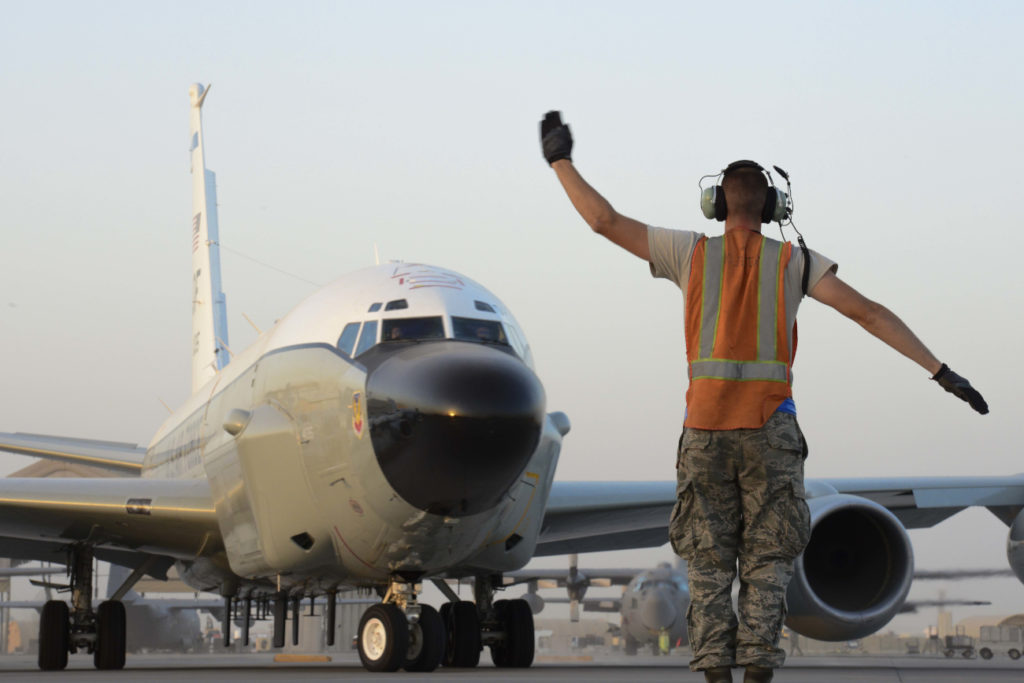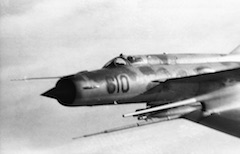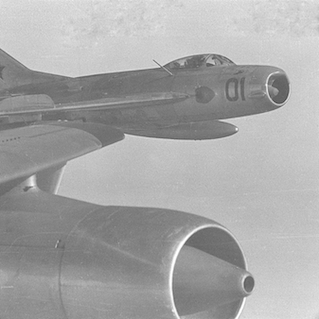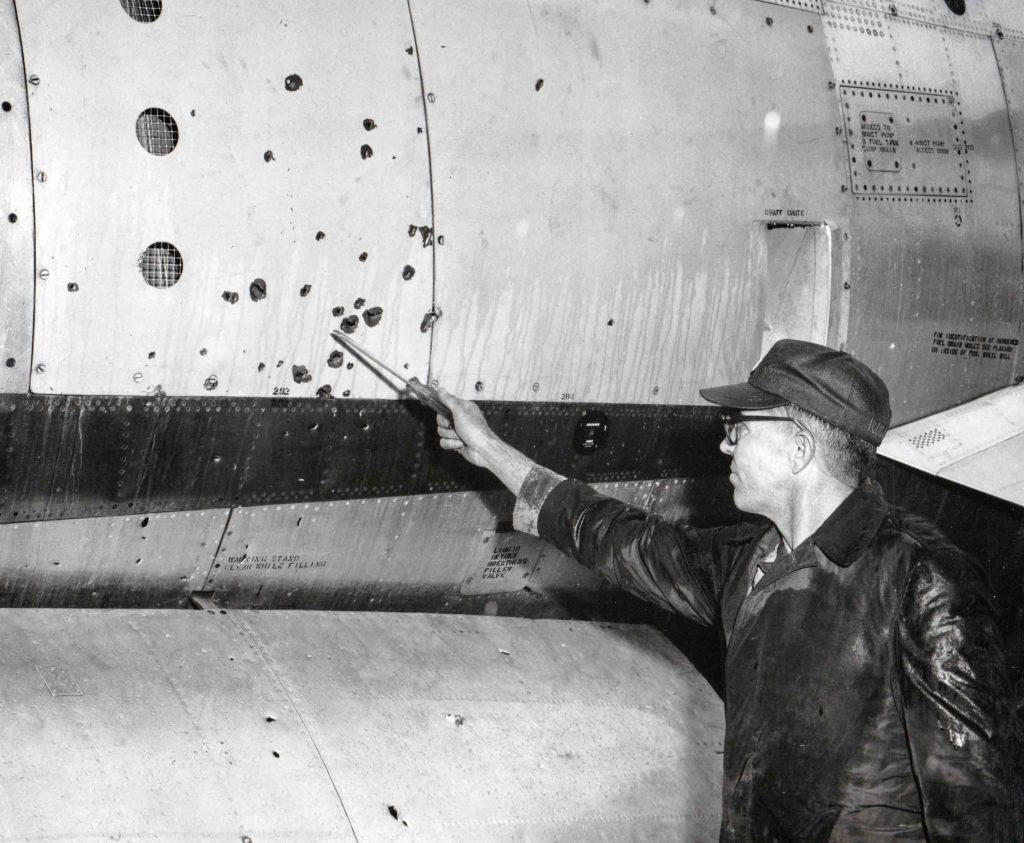Air Force Manned Reconnaissance at a Crossroads

After more than 25 years of successful but one-sided combat operations, plans to replace the U.S. Air Force’s legacy big-wing intelligence, surveillance, and reconnaissance (ISR) aircraft with new jets are in doubt. As Air Force planners see it, advances by “near-peer” adversaries such as Russia and China put these valuable but vulnerable assets at considerable risk. The Air Force already canceled recapitalization of the E-8C Joint STARS in favor of the Advanced Battle Management System — an integrated network of sensors across multiple platforms — with the rationale that any new non-stealthy airplanes would be easy prey for advanced fighters and anti-aircraft weapons. A recent Air Force announcement puts a replacement of the 60-year-old RC-135 reconnaissance fleet in similar jeopardy, an ill-considered choice that focuses exclusively on combat survival at the expense of essential peacetime operations.
Aging RC-135s Demand Replacement
The Air Force faces a compelling need to replace the elderly RC-135 fleet, which is slated to remain in service through 2040–2050 after some 80–90 years of operational flying. The RC-135 entered operational service with Strategic Air Command in 1962 in a program known as Office Boy. Stationed at Eielson Air Force Base in Alaska, the three airplanes were filled with linguists who monitored Soviet military radio frequencies and a pair of specialists who tracked radars and other electronic equipment. That same year, another variant of the C-135 began flying no-notice missions from the hazardous Shemya Air Force Base at the tip of the Aleutian Islands to monitor Soviet ballistic missile tests during re-entry on the Kamchatka Peninsula. Since then, multiple versions of the RC-135 have served continuously for the past 57 years, and they are among the oldest and most-flown aircraft in the U.S. inventory. Today, Offutt Air Force Base in Nebraska hosts 17 RC-135V/W Rivet Joints, two RC-135U Combat Sents, and three RC-135S Cobra Balls. Respectively, these variants perform airborne signals intelligence (SIGINT), specialized electronic intelligence (ELINT), and measurement and signature intelligence (MASINT). SIGINT intercepts both voice communication and electronic signals, specialized ELINT examines the technical functionality of electronic systems, and MASINT uses optical and non-visible-light sensors to gather data on ballistic missiles.
This long history of usage, exacerbated by 28 years of continuous combat operations, has taken its toll on the RC-135 fleet. Safety concerns have spawned contentious debate, prompted by a series of articles by military reporter Steve Liewer at the Omaha World-Herald. Following vigorous protests by the 55th Wing leadership and a superficial investigation conducted exclusively by the 55th Wing, the Air Force concluded that while old, the RC-135s are maintained and operated safely. These airplanes received new engines between 1999 and 2006, and contractor L-3 Communications regularly rebuilds the electronic mission systems. These improvements do not focus on the aging airframe itself, which has endured more than 60,000 hours of flight, despite having been designed for 12,000 hours. Moreover, quality control issues at L-3 nearly resulted in the loss of an RC-135 and its crew. Current Air Force projections that RC-135s can continue to fly for another 20–30 years under these ad hoc conditions are spurious at best and disingenuous at worst — a replacement is needed.
Defining the RC-135’s Mission(s)
The least understood but most critical issue in the RC-135 replacement debate is the evolving nature of its mission. Throughout the Cold War, American aerial reconnaissance aircraft comprised the Peacetime Aerial Reconnaissance Program (PARPRO, now known as Sensitive Reconnaissance Operations — SRO), with a strong emphasis on operations along other nations’ peripheries. In justifying these missions, the United States argued publicly and vigorously that they were passive, non-threatening collections of valuable intelligence that helped keep the peace. Information acquired by these missions informed U.S. leaders at all levels, inter alia, that Soviet military capabilities and (in some cases) intentions were not as threatening as perceived, which reduced overall Cold War tensions, especially in times of crisis.
A crucial weakness in this peaceful collection argument was that most of the reconnaissance airplanes were converted bombers, such as RB-29s, RB-50s, and RB-47s. The Soviets justifiably contended that these unarmed airplanes were otherwise indistinguishable from atomic-laden bombers, a claim that resonated with non-aligned and even NATO countries. In the aftermath of the Soviet shoot-down of an RB-47 in July 1960, the U.S. Air Force changed the designation of the type to “R-47” to eliminate the “B,” which stood for “bomber” and signaled offensive, threatening connotations, while maintaining the “R” for reconnaissance. This administrative sleight-of-hand fooled no one, least of all the Soviets, especially as the R-47 carried tail guns. The U.S. Air Force eventually resolved this dilemma by converting the C-135, an unarmed transport, into a strategic reconnaissance platform. This allowed the United States to more credibly claim that its RC-135 fleet was, in fact, a purely passive and unthreatening platform designed to keep the peace.
The RC-135’s widely acknowledged peacetime mission changed in 1991. Previously, the aircraft’s combat capability was a well-kept secret, known only to a select few theater commanders. Its success during Operation Desert Storm meant that it was suddenly among the first assets requested in any new conflict. Over the next 25 years, the RC-135 morphed into a highly visible and integral part of combat operations in Iraq, Bosnia, Afghanistan, Syria, and elsewhere. Peripheral peacetime collection missions continued, but at a reduced rate due to shortages of airplanes otherwise committed to combat operations and lengthy maintenance. Moreover, whatever “peaceful” cachet the entire RC-135 fleet developed during the Cold War has evaporated, as the Rivet Joint is now very clearly considered part of the “warfighter” community. Given this combat-oriented perspective, the Air Force has myopically defined the replacement of the entire RC-135 fleet solely on its survivability in an advanced combat environment while ignoring its peacetime reconnaissance mission.
Weighing RC-135 Survivability in War and Peace
The Air Force is certainly right to worry about the vulnerability of the RC-135 in an advanced combat environment given its large size, lumbering speed, and lack of armament. Although these aircraft flew stand-off combat support missions in Southeast Asia and during lopsided contingency operations such Urgent Fury in Grenada and Just Cause in Panama, it was not until Operation Desert Storm that RC-135s flew directly over the battlefield. In that war, absolute U.S. air supremacy eliminated any air-to-air threat, and complete ground dominance removed any danger from anti-aircraft artillery or surface-to-air missiles. Similarly, post-9/11 RC-135 operations over Afghanistan were effectively free from any threats. By necessity, however, the missions that began in 2014 to support American combat operations in Syria were required to operate off shore or over friendly territory, well away from Syrian — and later Russian — fighters and anti-aircraft defenses. Given the well-publicized American reliance for battlespace management on the “Iron Triad” of E-3 Airborne Warning and Control System (AWACS), E-8 Joint STARS, and the RC-135 Rivet Joint, any future adversaries will surely make destruction of these aircraft their top priority.
An equally essential component of the survivability equation is the tolerance of U.S. commanders for losing manned aircraft. During Desert Storm, U.S. planners expected to lose one or two RC-135s to relatively unsophisticated Iraqi defenses. Projected losses against a near-peer environment remain classified, but given the Air Force’s unwillingness to replace the E-8 JSTARS with another manned aircraft, the survivability of large, slow, non-stealthy aircraft in combat environments is quite likely to be low.
Analysts can estimate this risk tolerance, however, by examining Russian and Chinese peacetime aerial intercepts of large American manned aircraft such as RC-135s, EP-3Es, and P-8s. The Pentagon today routinely accuses Russian and Chinese interceptors of “unsafe and unprofessional” intercepts. The fear is that these intercepts may lead to a mid-air collision and create an international incident, such as the 2001 downing of a U.S. EP-3E near Hainan Island. Since 1946, however, there has been only one other mid-air collision involving Western reconnaissance aircraft when in 1987 a Soviet Su-27 clipped a Royal Norwegian Air Force P-3B (both landed safely). Clearly, the collision issue is more of a distraction than a legitimate historical concern.

Current complaints of interceptors approaching too closely (100-150 feet) pale in comparison to this Cuban MiG-21 Fishbed L backing away some 10-15 feet from the wingtip of an RC-135 during the 1980s. Source: U.S. Air Force photo via Geoff Hays.

A Soviet MiG-19 Farmer D less than 20 feet off the wing of an RB-47H on 24 September 1962. Soviet pilots were extremely aggressive and occasionally flew directly in front of the RB-47’s engines. Source: U.S. Air Force photo by Colonel Johnny Drost via Geoff Hays.
Throughout the Cold War, American and Western reconnaissance aircraft conducted tens of thousands of peripheral intelligence-gathering missions around the Soviet Union, China, and other nations. Intercepts were common, ranging in tenor from friendly waves between pilots to extended middle fingers to attacks resulting in the loss of more than 40 airplanes and crews due to intentional hostile acts. Few of these aerial intercepts or losses made the news, let alone merited strident public accusations from a rostrum in a Pentagon briefing room.

On 28 April 1965, two North Korean MiG-17 Frescos attacked an RB-47H over the Sea of Japan, but the crew landed safely in Japan and the jet was scrapped. Two other RB-47s were shot down with loss of seven lives. Source: U.S. Air Force photo, author’s collection.
After the Cold War, the occurrence of all aerial intercepts decreased to nearly nil as Russian air defense forces withered under the constraints of inadequate funding and improved Russo-American relations. Animosity with Russia resurfaced and, along with existing tensions with China, led to a resumption of both benign and provocative intercepts. The objectives of these reconnaissance missions remain the same — to gather intelligence about potential adversaries — and the nature of the intercepts are not all that different from those of the Cold War. What’s changed since 1992 that has led the Pentagon to label similar behavior “unsafe and unprofessional?”
The answer lies with the decreased risk tolerance of U.S. commanders. During the 1950s and 1960s, for example, crews were told to complete their missions even at the risk of their lives. Landing a crippled airplane in a hostile country, as with the case of the EP-3 at Hainan, was tantamount to a voluntary act of treason. During the 1970s and 1980s, reconnaissance aircraft aborted a mission only when overtly threatened by interceptor gunfire or hostile radar lock on. In interviews of recent reconnaissance unit commanders for historical research on aerial intelligence operations since 2000, however, they were unanimous in saying that no mission of any type — in war or peace requires risking the loss of an airplane and its crew. Reconnaissance commanders now direct crews to terminate missions for “unsafe and unprofessional” actions by interceptors. These might include high-speed passes at distances of 50–100 feet from the RC-135 or aggressive turns in front of the airplane, actions “old hands” consider tame when recalling fighters 10 feet from the RC-135’s wingtip or supersonic passes immediately above the RC-135 (“thumping”) expressly intended to make it lose control.
However noble this decreased risk tolerance might be, it ultimately reflects the needless risk of an airplane and crew to accomplish a mission that — on paper — is of sufficient importance to justify the flight but — in reality — is not important enough to risk an airplane or crew. If so, then why fly it at all, and, more importantly, why bother to fund the replacement of an airplane to fly a mission for which commanders aren’t willing to risk losing an airplane? Ultimately, this questionable lower risk tolerance adversely and negatively affects survivability assessments of the RC-135, arbitrarily skewing any replacement decision away from a manned big-wing airplane essential to peacetime peripheral reconnaissance and instead favoring a wartime unmanned networked solution with no demonstrated applicability to the peacetime mission.
The Replacement Debate, In Brief
The proposed plan to develop a blanket replacement for the entire RC-135 fleet is similar to the Air Force’s position on JSTARS, which ditches the big-wing manned aircraft for a networked, unmanned solution. Unfortunately, this ignores the RC-135’s current and future peacetime reconnaissance missions. RC-135V/W Rivet Joint signals intelligence missions still provide timely intelligence on potential and active “hot spots” such as North Korea and Venezuela, collect evolving electronic orders-of-battle of adversary defenses, function in a counternarcotic role, and serve as signaling platforms to let potential adversaries know, “We’re watching you.” RC-135U Combat Sent missions still collect fine-grain electronic intelligence to determine improvements to hostile weapon systems and to develop electronic countermeasures, notably Sapphire Sent missions in the South China Sea. RC-135S Cobra Ball missions continue to monitor foreign compliance with international arms agreements and gather technical data on the development of ballistic missile capability of countries ranging from Russia to North Korea.
The Air Force must instead divide the RC-135 recapitalization into wartime and peacetime requirements and choose at least one new manned big-wing aircraft, just as it has in seeking a replacement for the Open Skies Treaty OC-135s and approving a replacement for the Constant Phoenix “nuke sniffer” WC-135s. But what should this peacetime airplane look like?
Any selection is clouded by the ongoing debate over whether future intelligence aircraft should manned or unmanned. An unmanned platform does eliminate the concern about loss of a reconnaissance crew and may allow for longer missions, given the limits of crew duty day. However, plans to replace the Lockheed U-2 reconnaissance plane with drones both for mission capability and aircrew safety have been suspended, temporarily halting this drive toward exclusively unmanned systems. The primary advantage of a manned RC-135 replacement is the crew’s ability to make flexible, on-site mission changes that are not vulnerable to loss of satellite data and control links essential to drone operations, whether due to equipment malfunction or deliberate disruption by hostile forces. Of equal importance is the need for U.S. military commanders at all levels to move beyond the trending worldview that peacetime peripheral reconnaissance flights should be treated as a “business enterprise.” These are military operations intended to acquire military and political intelligence deemed essential to U.S. and allied-nation national security. RC-135 crews are highly trained military aviators and are well qualified to decide when an intercept puts their aircraft and crew at unacceptable military risk. Telling them that they should abort their mission if they feel an intercepting pilot is “unprofessional” devalues both their military judgement and mission purpose, the very reasons that a manned RC-135 replacement is preferable to a drone.
Another consideration for any peacetime RC-135 replacement is airframe size. A suitable replacement should be large enough — perhaps 787-sized — to accommodate back-end systems and personnel. It should also boast extreme range (including aerial refueling) and possess sufficient engine size to generate the necessary electrical power to run the collection, analysis, and distribution systems. For comparison, the Air Force’s plan to replace the Open Skies Treaty OC-135s seeks two “small airliner class aircraft,” suggesting equivocation about whether those aircraft are big-wing jets, such Boeing 737s, or smaller regional business jets. Business jet manufacturers are eager to cash in on this ambivalence about aircraft size in Air Force plans to replace several electronic warfare and intelligence, surveillance, and reconnaissance fleets. Smaller business jets offer economy of scale for countries that don’t require sizeable, dedicated fleets or have only limited geographic areas to cover. This strategy won’t work for the peacetime RC-135 replacement. The success of the RC-135 fleet has been its expandability in terms of capacity and capability. Filling a Gulfstream G550 with equipment and operators, despite inevitable miniaturization over time, leaves no room for long-term expansion of sensors or personnel.
Not One, But Two
The world today isn’t the Cold War world of yesterday, and Cold War requirements should not justify acquisition of new assets for tomorrow’s military needs. The RC-135’s innocence has long been compromised as it has evolved from its original peacetime role into a valuable combat asset, but both missions must be performed in the future. No single replacement solution can meet both of these disparate operational requirements. The U.S. Air Force must look beyond its obsession with warfighting to identify and procure a second manned big-wing peacetime replacement for the RC-135.
Robert S. Hopkins, III, MPH, PhD, is an independent scholar focusing on Cold War strategic airpower and aerial intelligence collection. A former U.S. Air Force pilot, he was qualified in 17 types of EC-, KC-, and RC-135s, and flew combat reconnaissance missions during Desert Storm.

